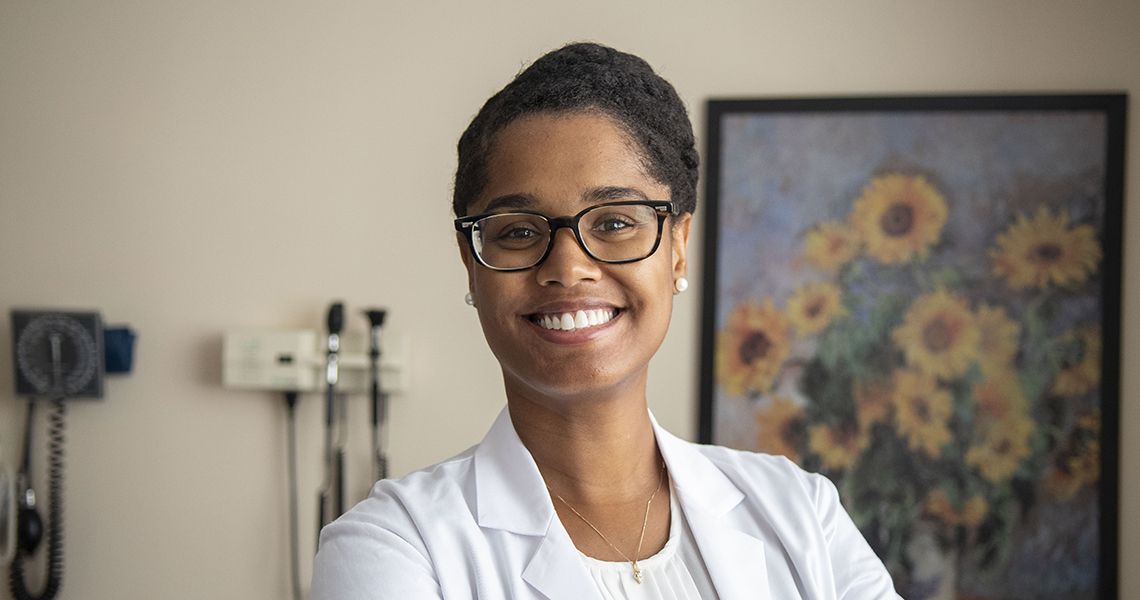Approximately 1 in 4 women will develop a pelvic floor disorder (PFD) in their lifetimes, similar to the risk of developing diabetes, breast cancer, or heart disease. PFDs, however, don’t garner the same level of attention or public awareness. Instead, many women suffer from this hidden epidemic in silence, unaware of available treatment options. Charelle Carter-Brooks, MD, MSc, assistant professor of obstetrics and gynecology at the George Washington University (GW) School of Medicine and Health Sciences, and a urologynecologist at the GW Medical Faculty Associates (GW MFA), has dedicated her career to the medical and surgical treatment of women with pelvic floor disorders such as urinary incontinence and pelvic organ prolapse.
Q: What is the pelvic floor, and what constitutes a pelvic floor disorder (PFD)?
Carter-Brooks: The pelvic floor is a group of muscles attached to the bony pelvis that supports our internal organs, such as the bowel, bladder, and uterus. It acts as a “sling” or a “hammock” to support the organs. When the muscles become weak or injured, for example during childbirth, a woman can develop a PFD. Other factors such as age, going through menopause and diabetes can affect the pelvic floor as well.
Q: There are three main types of PFDs, what are they?
Carter-Brooks: The three main types of PFDs are urinary incontinence (involuntary leakage of urine), pelvic-organ prolapse (the uterus, bladder, or bowel drops causing a bulge through the vaginal canal), and fecal incontinence (accidental leakage of gas or stool). There are many other types of PFDs, such as nighttime urination; bed wetting; frequent urination; loss of bladder control; leaking urine with a change in position, exercise, or sudden movement; constipation; straining or painful bowel movements; a vaginal bulge; vaginal or rectal pressure; vaginal dryness; pain with sexual intercourse; and injuries from childbirth.
Q: What are some of the misconceptions about PFDs?
Carter-Brooks: That is a great question. Some women assume that they have to live with these conditions because it is a normal part of aging or because their mother or grandmothers had it. Also, there is an assumption it is normal because we see a huge pad selection in the store. Sometimes women often aren’t comfortable discussing their conditions because they feel embarrassed or ashamed. If they do get the courage to tell someone, such as a doctor, they may dismiss their symptoms, use outdated treatments that do not work, or fail to provide them with a referral to the right specialist.
Q: What are the risk factors for PFDs?
Carter-Brooks: The main risk factor for developing a PFD is being a woman. We are all at risk. However, that does not mean you are bothered by the symptoms. If you are not bothered then you do not need treatment, but it can still be helpful to discuss prevention strategies or work on pelvic floor strengthening with a specialist. Other risk factors include increasing age, childbirth, weight gain, previous hysterectomy, and your genetic makeup.
Q: How dangerous is having a PFD?
Carter-Brooks: It is not dangerous to have a PFD. They can negatively impact your quality of life leading to social isolation, inability to work, depression, anxiety, falls, all of which can lead to a decline in your health and worsening other health conditions such as hypertension.
Q: Can you prevent getting a PFD?
Carter-Brooks: There are things you can do such as avoiding heavy lifting or straining. Trying to maintain a healthy weight. Eating a balanced diet.
Q: What can be done to address them? Is surgery the only option?
Carter-Brooks: There a number of treatment options that range from “wait and watch” to surgery. The most common treatment is pelvic floor muscle training which is non-invasive. This coupled with behavioral changes can make a huge difference for women.
For more information about pelvic floor disorders, check out the informational video on our urogynecology page or request an appointment online with Charelle Carter-Brooks, MD, MSc.




